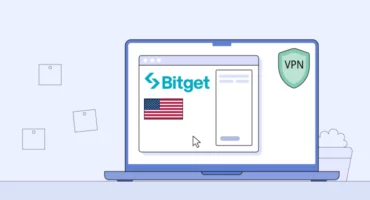Security Threats for NFT Buyers and Possible Solutions
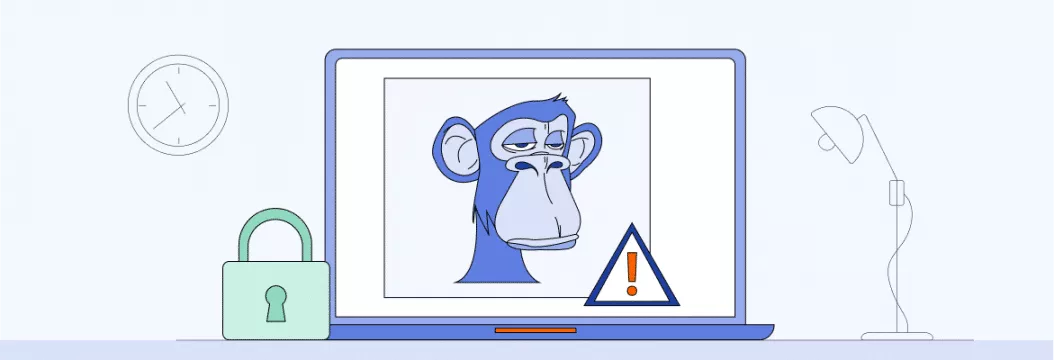
With the skyrocketing rise of non-fungible tokens (NFTs), more and more people are looking to invest in this promising technology. The NFT market is projected to reach nearly $20 billion by 2028, with an impressive CAGR of almost 24%. Pretty solid numbers – and not only for you, but for scammers as well. So, if you consider buying your first NFT, do not neglect the cybersecurity risks you may face.
According to a recent survey, more than $100 million worth of NFTs has been stolen since July 2021. And as new malicious tricks emerge, it’s time to find out how to make your NFT purchases safe. Read this article to learn how to protect yourself against the most typical threats for NFT buyers.
What are NFT scams?
An NFT scam is a malicious activity aimed at deceiving users and accessing to their digital wallets to steal their funds or non-fungible tokens. Scammers may also try to persuade you to invest in a fake NFT or illegitimate marketplace. And unfortunately, these risks are directly proportional to the rise of the NFT market. The statistics below show that the amount of NFTs lost due to cyberattacks has grown tremendously.

Here are several real-life examples of the latest major scams that make NFT owners reconsider their approaches to cybersecurity.
- In January 2022, a sports-based NFT platform Lympo lost $18.7 million because of a hot wallet hack.
- In February 2022, the OpenSea NFT marketplace suffered from a massive phishing attack, resulting in investors’ $1.7 million loss.
- One of the largest NFT hacks occurred in April 2022. $13.7 million was stolen after a cyber attack against the Bored Apt Yacht Club’s Instagram account.
- In May 2022, an NFT artist’s Twitter account was hacked. As a result, a phishing scam led to a $438K loss for the Beeple community.
- The Shifters and Aletha AI have recently suffered from a significant scam distributed via Discord, resulting in $2 million and $1.8 million losses, respectively.
How NFT scams work
NFTs are based on the same Blockchain technology as Bitcoin, Ethereum, and other cryptocurrencies. That is why the risks of NFT trading is similar to the most common crypto-related threats. While prioritizing users’ privacy, blockchain solutions have certain security vulnerabilities. As a result, hackers and scammers come up with various malicious techniques allowing them to steal users’ credentials and gain access to their digital wallets.
In most cases, NFT scams can be divided into three main categories:
- Phishing and social engineering. Cybercriminals distribute malicious links, social media posts, pop-ups, and fake giveaways to steal users’ credentials.
- Investment schemes. Scammers aim to trick people into buying fake digital assets.
- Malware attacks. Hackers spread NFT-related viruses to steal users’ private data.
Now, let’s look at the most popular types of NFT frauds.
7 common NFT cybercrimes
There are various types of NFT cybercrimes, from rug-pull scams and phishing emails to fake tokens and pump-and-dump schemes. Let’s take a closer look at those malicious schemes and learn how to secure your NFT and crypto purchases.
1. Rug-pull scams
The rug-pull technique involves the creation of a new NFT collection that seems completely legitimate and initially inspires the audience’s confidence. The inventors announce various events, mint passes, giveaways, and build trust to the project via social media. This way, they encourage people to invest their funds into the new collection. However, once users put their money into the NFTs, the developers suddenly disappear without a word.
The most famous example of a rug-pull scam is the Frosties NFT collection. Its creators made numerous promises to investors, including exclusive memberships and giveaways. But as soon as the project raised nearly $1.3 billion, they instantly closed the website and social media accounts.
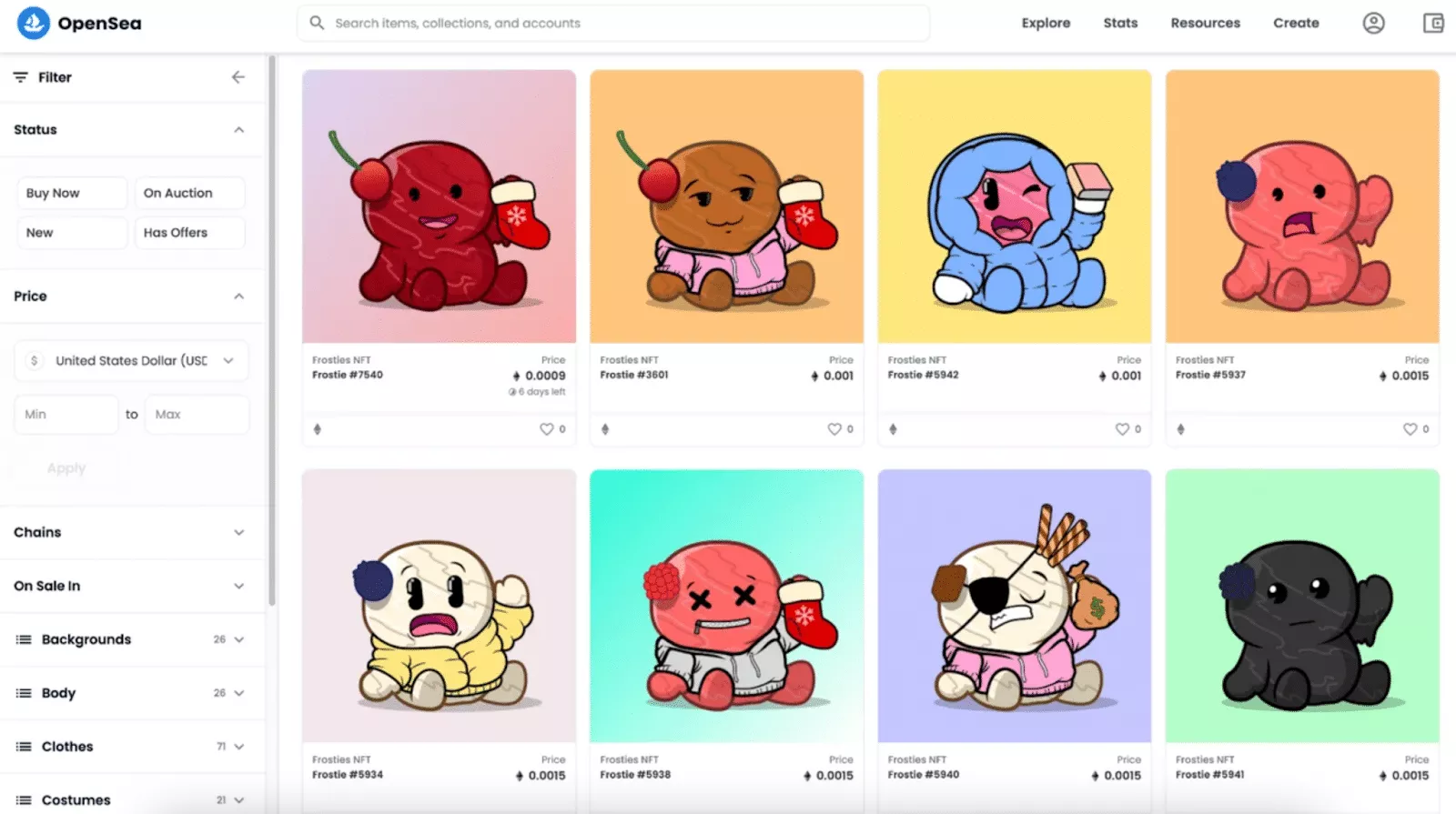
How to avoid it?
- Carefully check new NFTs before making investments
- Learn the background of NFT creators
2. Pump-and-dump schemes
Pump-and-dump scams are common for stocks, cryptocurrencies, and non-fungible tokens. This scheme involves artificial inflation of a digital token’s value, which experiences a rapid rise and fall in a short period of time.
Scammers standing behind this type of fraud are buying up a large number of NFTs, which raises the price of a certain collection sky-high. Then, investors start to put their money into a promising project. However, at some point, malicious actors suddenly sell off the purchased NFTs, making the price drop sharply. As a result, the investors are left with valueless assets that were recently worth a fortune.
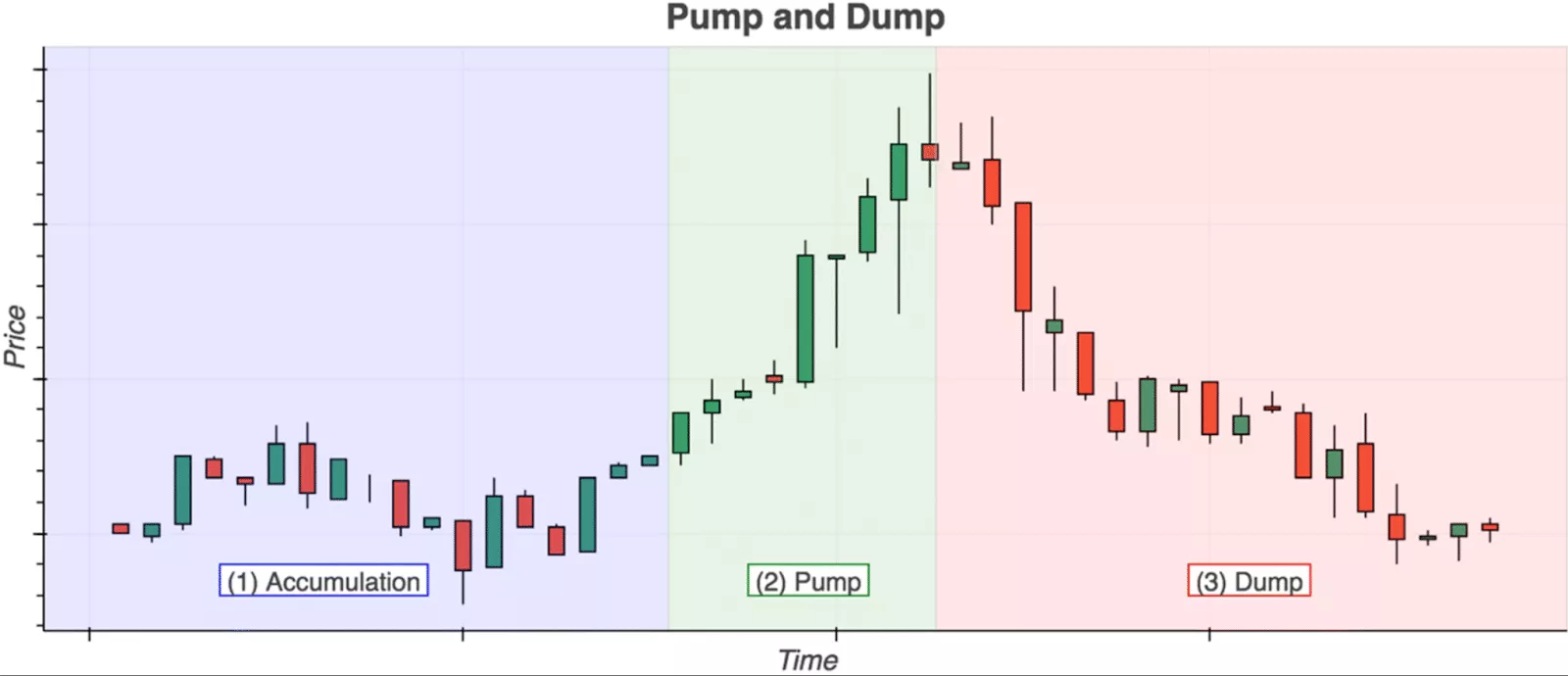
How to avoid it?
- Do your research before investing in an unverified NFT collection
- Do not buy into a sharp growth in an NFT value
3. Fake NFTs and malicious marketplaces
Hackers tend to create malicious websites and fake NFT marketplaces aiming to compromise users’ private data and steal their funds. Many of those platforms may look legit at first sight. However, they often appear to be evil clones of valid websites posing a hacking threat to NFT buyers.
Furthermore, even if you purchase an NFT on a trustworthy marketplace, it may also turn out to be fake. How come? Well, malicious actors often plagiarize NFT artworks, creating copies of unique tokens. As a result, instead of purchasing a real digital asset, you may fall victim to fraud and get an imitation with no actual value. NFT marketplaces like OpenSea are currently struggling to find a solution allowing them to spot and reduce “copymints” and plagiarized artworks.
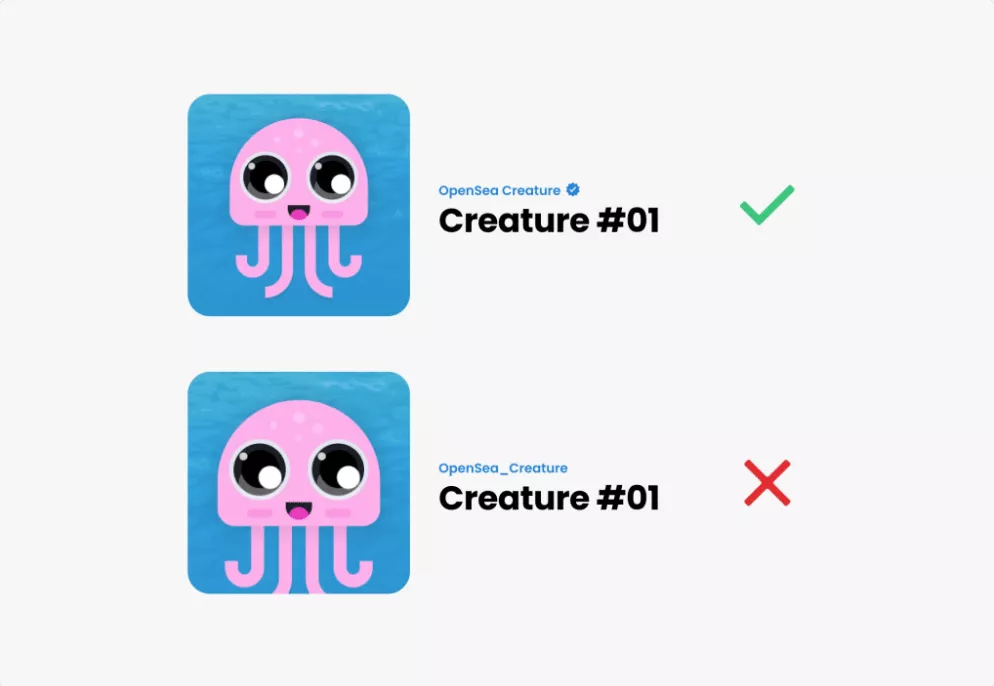
How to avoid it?
- Use only credible NFT marketplaces like OpenSea, Rarible, Binance, and SuperRare.
- Avoid NFTs with suspiciously low prices
- Do not buy into too-good-to-be-true deals
- Verify the seller’s contact information
- Check the desired artwork’s trading volume
4. Phishing attacks
A phishing attack is one of the most widespread types of scams that has also become common in the NFT market. Hackers contact their victims via email and use social engineering techniques to make them click on malicious links.
For instance, a scammer may pretend to be a platform’s support service asking you to solve a problem with your account. Alternatively, it could be a free NFT offer or a tempting deal encouraging you to act immediately. However, if you click on the provided link, cybercriminals will compromise your private data. Most often, an NFT phishing attack aims at accessing your wallet keys and stealing your funds.
Here’s a typical example of an NFT phishing scam. At first glance, it seems to be a real email sent by the OpenSea support team. It asks you to migrate your Ethereum listings to a new smart contract and provides a corresponding link. However, once you click on it and fill out the proposed form, your credentials will end up in the wrong hands.
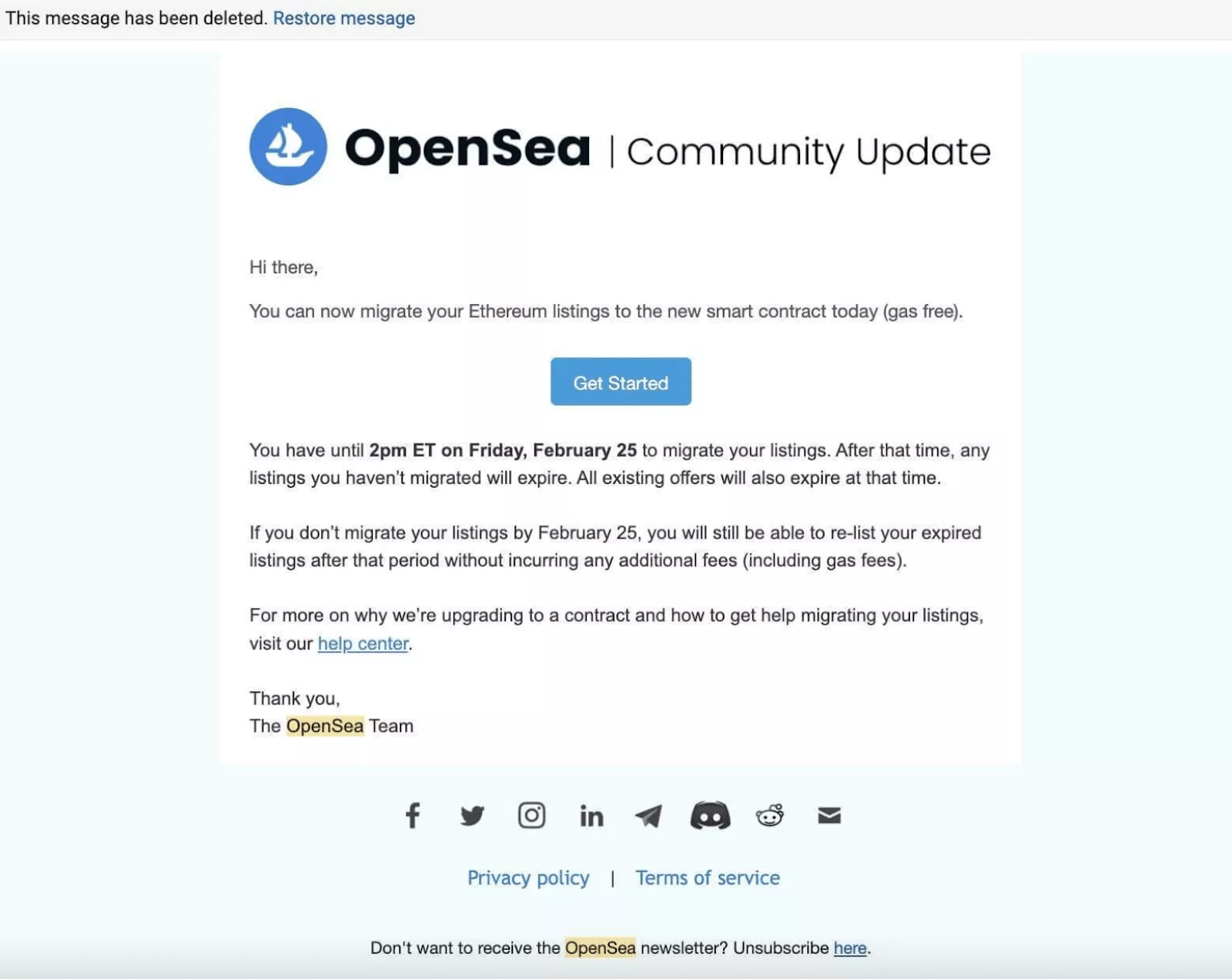
How to avoid it?
- Do not click on suspicious links
- Check the sender’s email address
- Go directly to your NFT platform account
- Report potential fraud to the support center
5. Fake NFT investment scams
Malicious actors can try to scam investors through social media accounts on Discord, Twitter, Instagram, and Facebook. Normally, these are fake giveaways or “new NFT” releases that never actually happen. This scheme may involve impersonation, social engineering tricks, and other fraudulent techniques to lull potential investors into a false sense of security. However, once a victim gets hooked, the scammers disappear with their funds.
One of the most well-known examples of an NFT investment scam was the Evolved Apes project. More than 10,000 unique NFTs were supposed to be used in an upcoming fight game. However, the game itself was never released. The project’s creator, “Evil Ape,” vanished with $2.7 million without even paying the NFT artists working on the project.

How to avoid it?
- Do not participate in suspicious giveaways
- Check social media accounts for potential impersonation
6. NFT-related malware attacks
All blockchain-based technologies, including NFTs, are relatively new, which makes them vulnerable to different types of viruses and malware attacks. So before investing in non-fungible tokens, you should be aware of NFT security issues and build up your defense.
Most NFT viruses are spread via phishing emails and malicious links. However, your device may also get infected with malware due to the airdropping technique. This approach allows hackers to send you a virus when you get a free or promotional NFT directly to your digital wallet. As a result, malware secretly settles in your wallet and sends your private data to cybercriminals.
The fake Pixelmon is an example of a malicious NFT website that infects users’ devices with malware. The legitimate Pixelmon is a popular metaverse game with a large and active community. However, it was eventually impersonated by malicious actors. A deceptive copy of the legitimate site installs password-stealing malware on users’ devices.

How to avoid it?
- Verify the website’s legitimacy before installing any files
- Check if the website uses the HTTPS protocol
- Protect yourself with premium antivirus and VPN software
How to buy NFT safely?
Now that you know that the world of NFTs is far from safe, it’s time to learn how to protect yourself. Here are the most effective security measures you can take to secure your NFT purchases.
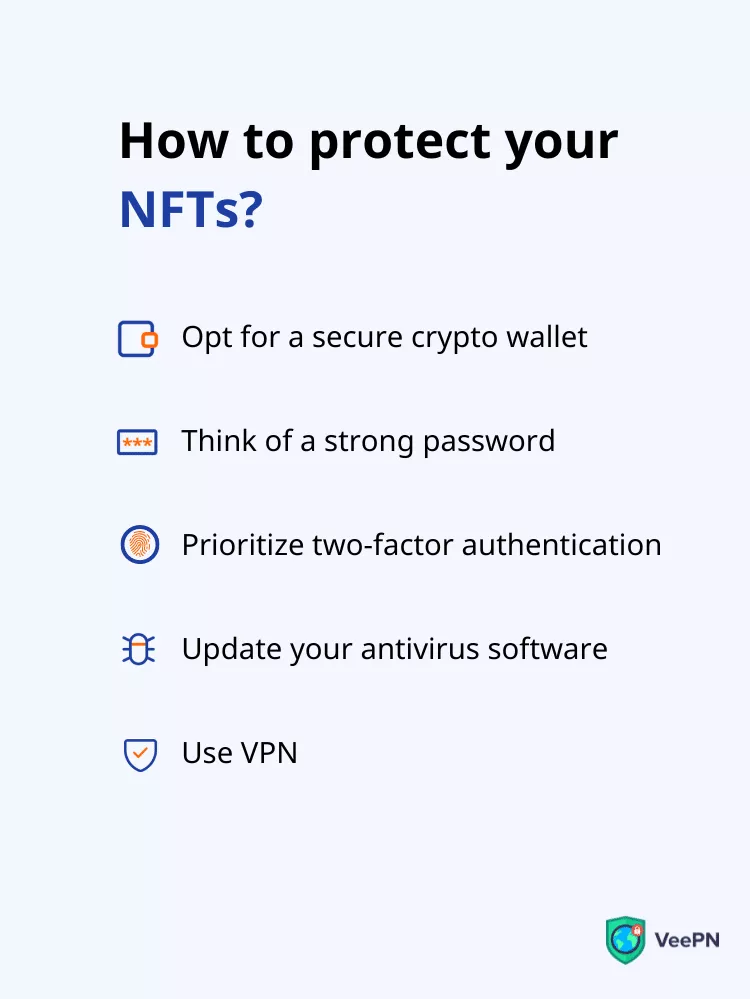
Opt for a secure crypto wallet
First and foremost, store your NFTs in a well-protected digital wallet. Most hacks and cyber attacks target hot wallets that hold digital assets online. So it’s worth keeping your tokens and crypto assets in a cold (offline) wallet. You may opt for one of the most reliable platforms, such as Coinbase, Exodus, or TrustWallet, to store your NFTs. Also, keep in mind that the chosen wallet should be supported by the marketplace you’re using.
Think of a strong password
Your password is the main line of defense in the fight against cybercriminals. That is why you need to make sure your wallet keys aren’t easy to compromise. A password manager tool will help you create, store, and manage unique passwords for every virtual wallet and account. On top of that, you will get public and private keys generated automatically.
Prioritize two-factor authentication
Two-factor authentication (2FA) is one of the most critical security measures for storing crypto and NFTs. This solution is a combination of two key security factors:
- Your password
- Security code, application, or biometric authentication
This additional verification step won’t allow hackers to access your crypto wallet or personal account, even if they’ve managed to steal your password.
Update your antivirus software
To ensure no NFT malware can compromise your cybersecurity, it’s worth using a premium antivirus tool and regularly updating it. Such software conducts deep system scans that will help you detect and eliminate NFT-related threats, such as Discord viruses and airdrop malware.
Use VPN
A virtual private network (VPN) is a must-have security solution allowing you to defend yourself from NFT scams, man-in-the-middle attacks, and malicious links. A VPN also handles many privacy risks by encrypting your data and running it through a secure tunnel. So you won’t have to worry about third-party trackers, personal information leaks, and potentially infected websites. However, you should pick a reliable service provider since free VPNs often lack essential features and may even turn out to be fake.
Secure your NFT trading experience with VeePN
Looking for a powerful tool to protect your NFT purchases? Check out VeePN! It’s a trustworthy VPN service that provides many helpful security features and ensures top-notch AES-256 encryption. VeePN will shield your online activities from third-party monitoring and protect you even when using public WiFi. In particular, the NetGuard feature will help you avoid dangerous websites and stay away from NFT threats. Try VeePN today and safeguard yourself with a 100% money-back guarantee.
FAQ: What are NFT security threats?
Although blockchain solutions are relatively safe, buying and selling NFTs is still quite risky. That’s due to numerous scams, fake investment schemes, and other malicious techniques striving to compromise users’ security. So it’s a good idea to safeguard yourself and stick to the most effective security measures. In particular, you can use a VPN, update your antivirus software, and create a reliable crypto wallet.
- Rug-pull scams
- Pump-and-dump schemes
- Plagiarized NFTs and fake marketplaces
- Phishing scams
- Investment fraud
- Malware attacks
Today, the NFT market is on the rise, with more and more investors willing to join. Some are interested in buying non-fungible tokens to collect digital artworks, while others strive to access unique games. Finally, some investors purchase NFTs believing they will increase in value in the future. But whatever the reason, one should watch out for various potential cyber threats, such as NFT scams and fake assets.
VeePN is freedom



